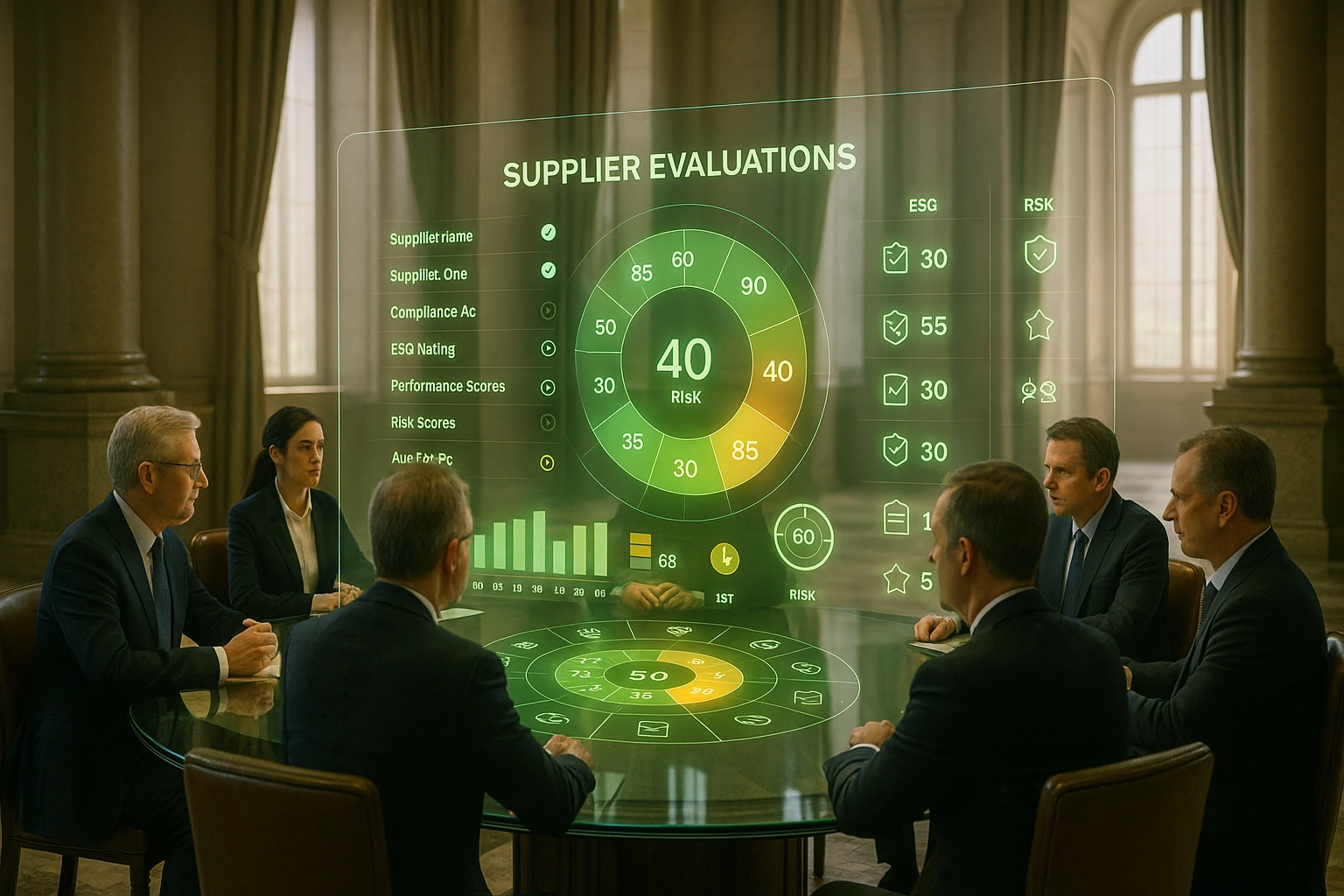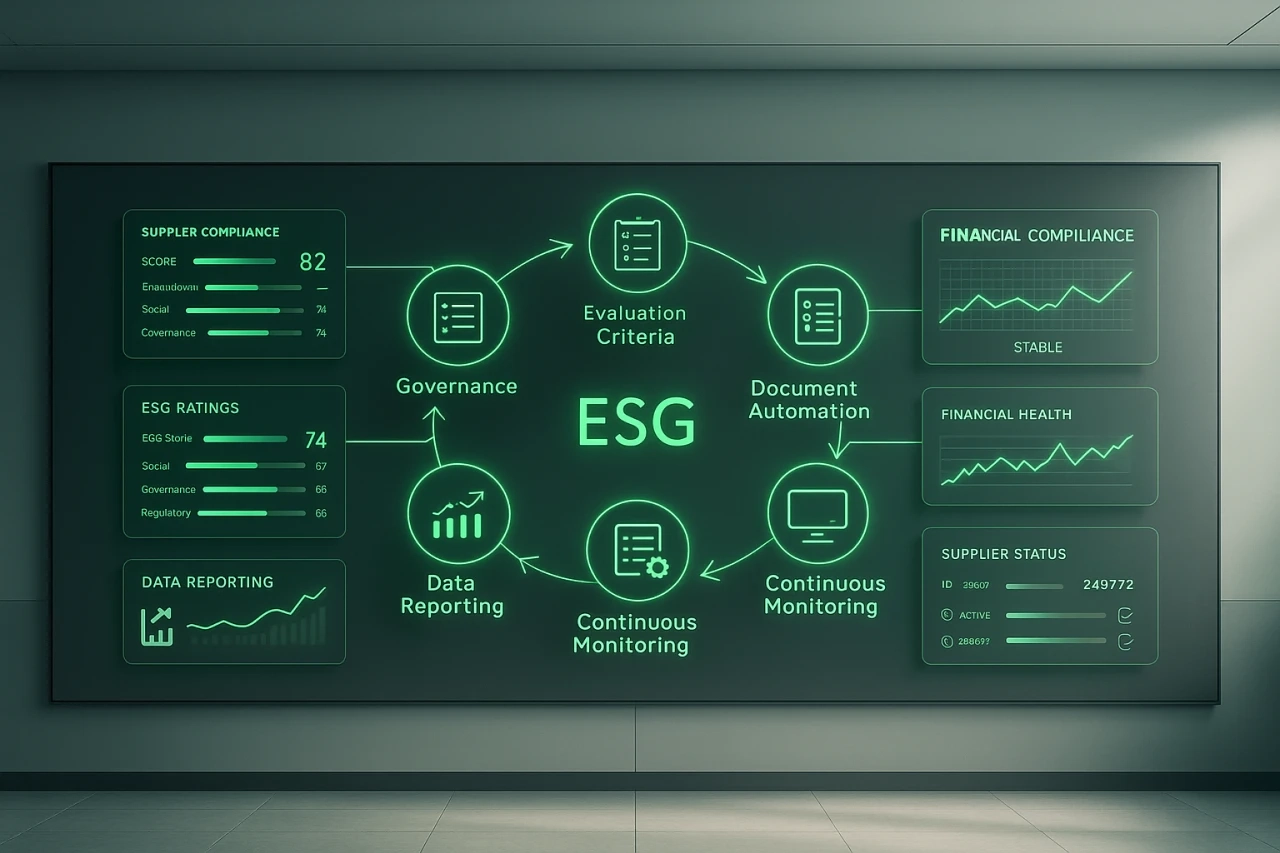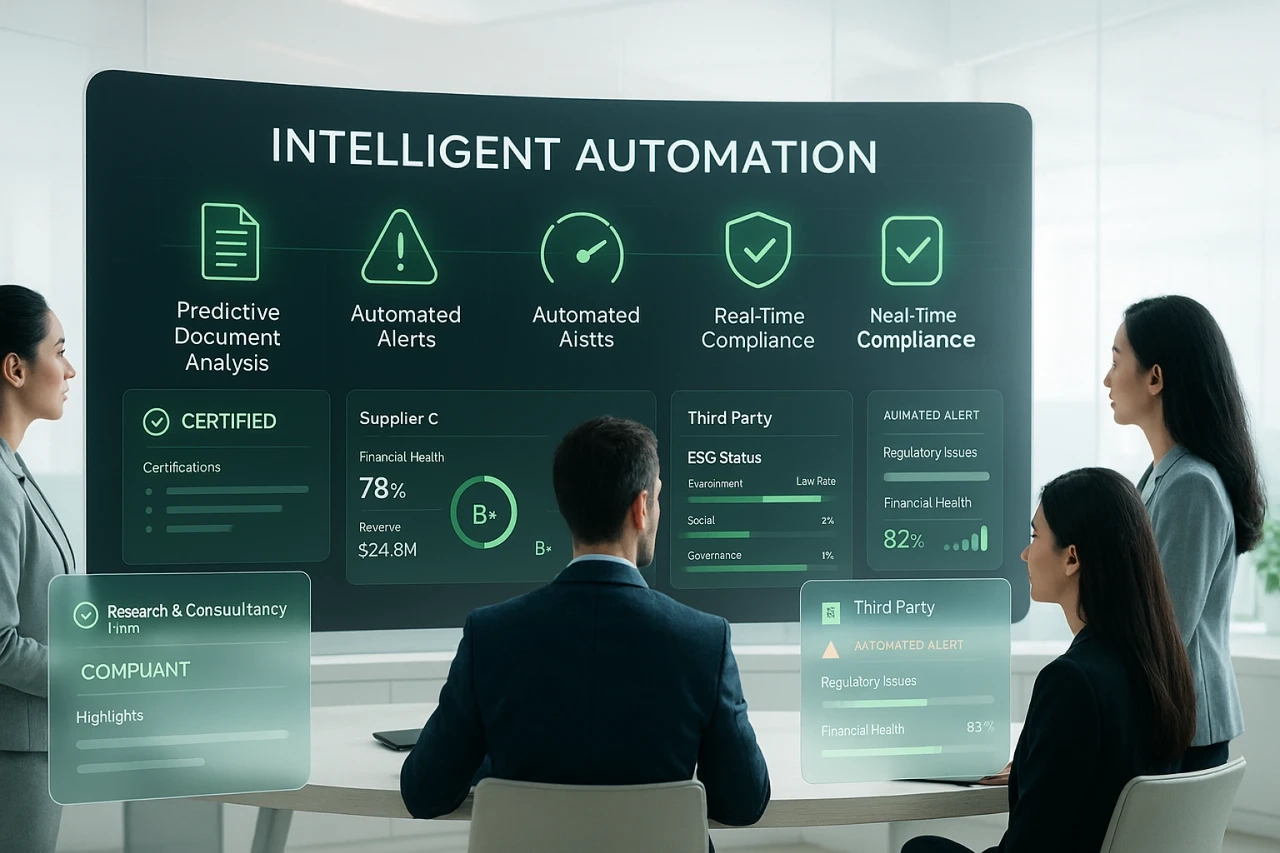Supplier Evaluation in the Public Sector: A Strategic Governance Challenge

The public sector accounts for a significant portion of economic activity in France and involves a large number of contract holders. As such, public sector actors face critical challenges in managing supplier relationships—especially since third-party qualification has become a cornerstone of public procurement strategies. Beyond basic oversight, it now forms part of a broader approach to external provider governance, aiming to establish collaborative and resilient relationships.
Why Evaluate Public Sector Suppliers?
Measuring supplier performance for public entities addresses key strategic concerns. According to the OECD, rigorous management of external stakeholders significantly improves transparency and accountability in public procurement. This approach aligns with a logic of collaborative governance rather than mere control.
In the social housing sector, evaluating maintenance providers is now essential to ensure service quality and tenant satisfaction. As highlighted in the 2023 ObsAR barometer, this approach supports “continuous improvement in purchasing processes” and encourages sharing best practices across public entities.
Key Evaluation Criteria
Public organizations must structure supplier evaluations around core criteria:
- Regulatory compliance: adherence to GDPR, DORA, NIS 2, CSRD, and Spaser regulations
- Operational performance: service quality and deadline compliance
- Risk management: capacity to ensure business continuity
- Financial capacity: supplier’s financial health and economic stability
- CSR commitment: responsible social and environmental practices
- Innovation capacity: ability to meet sector-specific requirements
- Bank detail verification: to combat fraud
A thorough market analysis usefully complements these criteria, allowing procurement teams to contextualize supplier evaluations within their competitive environment. This comparative approach enhances decision relevance and improves cost-performance balance.
Go Further
The French Business Mediator also recommends incorporating reciprocity, allowing suppliers to evaluate their relationship with public buyers—a criterion now included in the Responsible Supplier Relations and Purchasing Charter (RFAR).
Public Sector or Public Sectors?
Public entities in France face diverse challenges in supplier management. Whether it’s a social housing agency managing thousands of homes, a departmental fire and rescue service (SDIS), or a local authority, risks must be assessed using tailored approaches.
What Makes Public Sector Supplier Evaluation Unique?
Public organizations have specific characteristics that directly impact supplier analysis. According to the OECD, public procurement accounts for an average of 12% of GDP in member countries, and up to 20–30% in developing economies—giving governments significant leverage to promote transparency and sustainability in supply chains.
Supplier selection in the public sector generally follows one of two paths: open competitive bidding or restricted procedures with approved supplier lists. In both cases, predefining clear evaluation criteria is essential to ensure a fair and effective process.
Local governments must also implement a comprehensive supplier governance framework, clearly defining roles, responsibilities, and decision-making processes. This supports collaborative—rather than punitive—relationships with third-party partners.
What Role Does CSR Play?
Corporate Social Responsibility (CSR) is now a central pillar of supplier evaluation in the public sector, with increasingly structured integration of ESG criteria. The 2023 Procurement Act requires a minimum 10% weighting for social value in tender evaluations.
To be effective, CSR integration requires a partnership approach with suppliers. Transparency around CSR weighting in tenders transforms suppliers into genuine change agents.
The Public Sector Evaluation Process
The public sector supplier qualification process traditionally involves three key stages: pre-qualification, ongoing evaluation, and post-contract review. According to UGAP, France’s leading public buyer, this cyclical model ensures collaborative governance throughout the supplier relationship.
In construction and public works, local authorities are increasingly using standardized evaluation questionnaires to assess contractor performance. The Union of Public Purchasing Groups recommends incorporating sector-specific performance indicators: compliance with deadlines, material quality, environmental standards, and subcontractor management.
Collaborative evaluation also involves transparently sharing results with suppliers, creating a virtuous cycle of continuous improvement.
How Can This Process Be Improved?
To optimize and automate supplier evaluation, public entities can implement several innovative strategies:
- Shared evaluations: reduce supplier fatigue by sharing results between public organizations
- Proportionate approach: tailor evaluation intensity to specific risks and issues
- Digitalization: use digital tools to automate data collection and analysis
- Two-way evaluation: allow suppliers to provide feedback on their relationship with the public buyer
As noted by the State Procurement Directorate, “a supplier’s performance also depends on the quality of the relationship established by the buyer,” highlighting the importance of a balanced and collaborative approach.
Optimize Your Supplier Evaluation Process
Discover how local governments and public organizations can streamline third-party governance while improving regulatory compliance.
The Role of Social Housing in Supplier Evaluation
The social housing sector is a specific case in public supplier evaluation. With 5.2 million housing units in France and over €13 billion in annual spending, social housing organizations are major economic players. According to the Social Housing Union, supplier quality directly impacts tenant satisfaction and long-term asset value.
Social landlords have developed innovative governance approaches. For instance, Paris Habitat implemented a collaborative evaluation system involving technical teams, building supervisors, and tenants to assess maintenance providers.
Why Is Social Housing Unique?
Several factors make this sector distinctive:
- Dual responsibility: balancing social mission and efficient asset management
- Diverse stakeholders: a social landlord manages over 200 supplier contracts on average
- User impact: service quality directly affects tenant daily life
- Proximity issues: technical interventions require close coordination with residents
In social housing, supplier evaluations must include specific indicators like responsiveness to emergencies, quality of interactions with tenants, and ability to work in socially sensitive environments. These dimensions are vital to delivering services tailored to the specific needs of public housing residents.
Effective Solutions for Successful Evaluation
To ensure successful public supplier evaluations, it’s essential to adopt integrated, collaborative solutions like those offered by Aprovall. Digital tools enable automated data collection and real-time monitoring, reinforcing third-party governance. Sharing evaluations among public entities reduces administrative burden and supplier fatigue while improving transparency.
Two-way evaluations promote constructive dialogue between buyers and suppliers, building trust and stronger relationships. Tailoring evaluation metrics to sector specifics—such as social housing or construction—improves analysis relevance and long-term outcomes.
What Are the Benefits for the Future?
Implementing collaborative evaluation solutions brings tangible, lasting advantages. Effective evaluation enhances the operational resilience of public bodies by anticipating third-party risks. It also fosters innovation and sustainable supply chain performance. The OECD emphasizes that collaborative supplier management practices improve public service quality and optimize resources.
By embracing these tools, public sector actors can become leaders in responsible, agile governance, well-prepared to meet future regulatory and societal challenges.
Strengthen the Resilience of Your Supply Chain
Public organizations face growing demands in third-party evaluation. Aprovall supports you with tailored solutions for the public and social housing sectors.
Toward Collaborative Public Supplier Governance
Supplier evaluation in the public sector has evolved significantly—from basic compliance checks to a strategic governance initiative. As seen with social housing, sector-specific requirements call for tailored approaches addressing proximity and user-service challenges.
Digital transformation offers unprecedented opportunities to share evaluations, reduce administrative workload, and reinforce the cooperative model of public bodies. By adopting a cooperative—not punitive—model, public buyers can build long-term relationships with third-party providers.
Aprovall supports this evolution by offering collaborative evaluation solutions tailored to public sector requirements. Our secure ISO 27001/27701-certified platform helps manage third-party compliance efficiently while reducing administrative burdens through a shared model trusted by over 450,000 partners worldwide.
These articles might interest you
-
 16 July 2025TPRM & Innovation: How Procurement Departments Are Becoming Catalysts for Product PerformanceSecteurInnovation is no longer a luxury. For industries such as manufacturing, construction, luxury goods, or retail, it is a strategic necessity — essential for differentiation, regulatory compliance, and staying competitive in increasingly volatile markets. As products become more complex and development cycles accelerate, Procurement Departments are being called to the forefront. Their mission goes far […]
16 July 2025TPRM & Innovation: How Procurement Departments Are Becoming Catalysts for Product PerformanceSecteurInnovation is no longer a luxury. For industries such as manufacturing, construction, luxury goods, or retail, it is a strategic necessity — essential for differentiation, regulatory compliance, and staying competitive in increasingly volatile markets. As products become more complex and development cycles accelerate, Procurement Departments are being called to the forefront. Their mission goes far […]Read more
-
 02 June 2025The 6 Pillars of an Effective Supplier Evaluation SolutionSecteurAccording to a 2025 Accenture study, 63% of companies are undergoing transformation. As a result, CIOs, procurement managers, and compliance officers are rethinking their approach to third-party governance. In both public and industrial sectors, it is no longer just about collecting administrative documents, but about structuring supplier relationship management to sustainably strengthen operational resilience. Adopting a collaborative evaluation solution based […]
02 June 2025The 6 Pillars of an Effective Supplier Evaluation SolutionSecteurAccording to a 2025 Accenture study, 63% of companies are undergoing transformation. As a result, CIOs, procurement managers, and compliance officers are rethinking their approach to third-party governance. In both public and industrial sectors, it is no longer just about collecting administrative documents, but about structuring supplier relationship management to sustainably strengthen operational resilience. Adopting a collaborative evaluation solution based […]Read more
-
 05 June 2025Automated Evaluation Solutions: How to Streamline Without Sacrificing QualitySecteurAutomating evaluations is becoming an essential step for organizations looking to strengthen their third-party governance. IT decision-makers, especially in construction, industry, and the public sector, are seeking to combine efficiency and time savings with uncompromising quality assurance. Given concerns around the reliability of automation tools and the need for consistent performance, it’s crucial to debunk myths with recent advances in AI and intelligent […]
05 June 2025Automated Evaluation Solutions: How to Streamline Without Sacrificing QualitySecteurAutomating evaluations is becoming an essential step for organizations looking to strengthen their third-party governance. IT decision-makers, especially in construction, industry, and the public sector, are seeking to combine efficiency and time savings with uncompromising quality assurance. Given concerns around the reliability of automation tools and the need for consistent performance, it’s crucial to debunk myths with recent advances in AI and intelligent […]Read more
-
 27 February 2025TPRM Deployment in the Public Sector: Insights and ExpertiseSecteurIn an environment where interactions with third-party partners play a crucial role in the functioning of public organizations, proactive risk management for these relationships has become a strategic priority. Third-Party Risk Management (TPRM) is now an essential approach to ensure regulatory compliance, reduce financial risks, and prevent cyber threats. With more than 430,000 third parties managed worldwide, Aprovall has established […]
27 February 2025TPRM Deployment in the Public Sector: Insights and ExpertiseSecteurIn an environment where interactions with third-party partners play a crucial role in the functioning of public organizations, proactive risk management for these relationships has become a strategic priority. Third-Party Risk Management (TPRM) is now an essential approach to ensure regulatory compliance, reduce financial risks, and prevent cyber threats. With more than 430,000 third parties managed worldwide, Aprovall has established […]Read more
